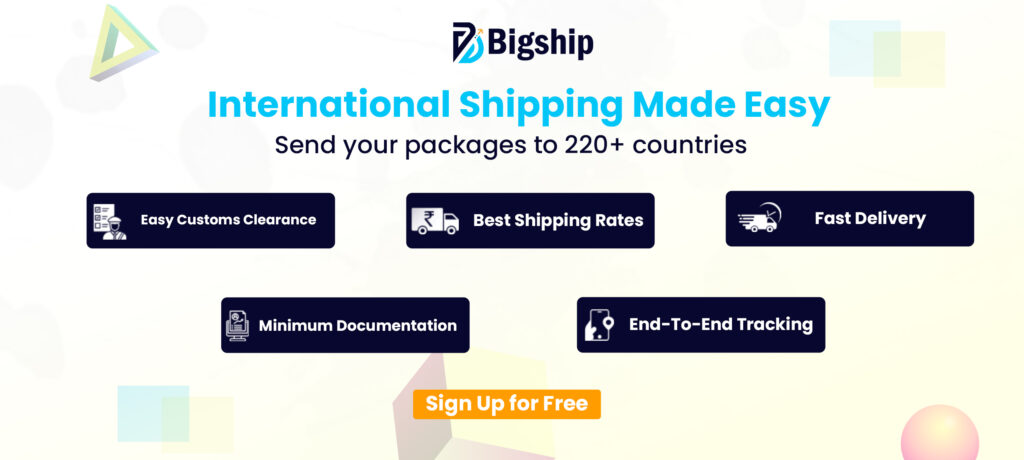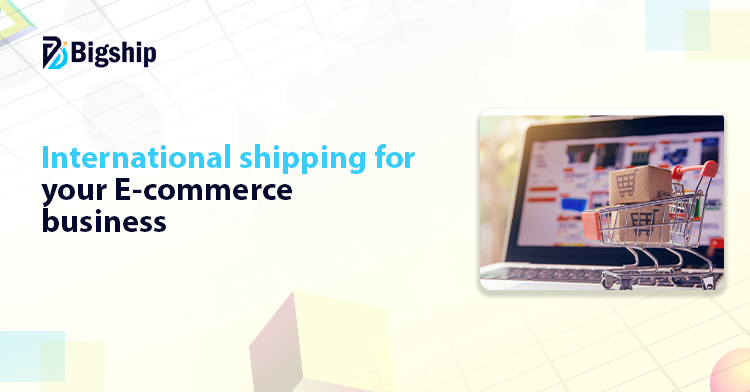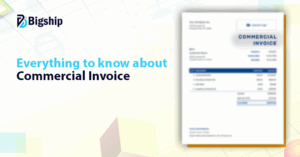Going global is now part of daily business for online sellers. But the real challenge begins after your customer places an order, getting that product safely across continents. Startup or a growing brand, international shipping for e-commerce demands more than just packing and posting. It requires the right partners, reliable systems, and a deep understanding of global e-commerce shipping dynamics.

Choosing carriers or managing customs, every decision impacts your customer’s experience. This guide will help you navigate those decisions and streamline your cross-border shipping strategy with confidence.
What does e-commerce international shipping mean?
E-commerce international shipping means sending your products to buyers in other countries. You don’t just sell in your own country anymore. You sell to people living far away.
You can send your orders by air, sea, or road. The method depends on the size, cost, and how fast your buyer wants it.
This shipping method helps your online store grow. You get to reach buyers in new countries. More reach means more chances to sell.
How does international shipping help in growth of e-commerce businesses?
Selling to other countries can push your business forward. You don’t stay limited to local buyers and can reach more people worldwide. More and more shoppers now buy from global online stores. Many of them shop at least once a week and this trend is not slowing down.
Reports say international shipping for e-commerce will keep rising every year. The total value may touch USD 1 trillion by 2030 and that’s huge. Sending orders across borders helps you find new buyers. When they get a good product and fast delivery, they come back to shop again. So, if you want more people to know your brand, shipping internationally is a smart move.
Top countries for global e-commerce shipping from India
Some countries are better for global e-commerce shipping from India. These countries have many online shoppers and good delivery systems.
The top ones include the United States, Canada, United Kingdom, Australia, Germany, France, and the UAE. Buyers from these countries trust Indian sellers. They often shop for clothes, electronics, and handmade goods from India.
The U.S. and the UAE are strong markets. Orders from India to these countries move fast and often. The UK and Germany also have a large number of online buyers. So, if you plan to ship worldwide, start with these countries. They already have a growing demand for Indian products.
Key things to consider before starting international shipping for e-commerce
Shipping products across borders takes more than just packing and posting. A few things can affect how smoothly or slowly your delivery goes. These are the things you must check when planning international shipping for e-commerce.
Customs Rules in Each Country
Every international order goes through customs. This is the government department that checks what’s going in or out of a country. If you don’t follow their rules, your parcel may get stuck or returned. To avoid problems, make sure your documents are correct. Also, check if your products are allowed in that country.
All the Paperwork You Need
International shipping for e-commerce always needs documents. These are used to clear customs. If anything is missing or wrong, your parcel will get delayed.
Here are some important ones:
- Commercial invoice shows item value, quantity, and description.
- Packing list shows item weights and what’s in each box.
- Shipping label and tracking number help identify and track the parcel.
- Certificate of origin shows where the goods are made.
- Air waybill or bill of lading is needed for air or sea shipping.
- Customs declaration includes the shipment value and content.
- Some countries may ask for permits or special certificates.
Taxes, Duties, and Extra Costs
International shipping for e-commerce comes with added costs. Every country has its own charges. These include:
- Taxes: Governments apply a tax like GST or VAT. It’s based on the product’s value.
- Duties: These are extra charges based on the product type, cost, and where it comes from.
- Fees: These are handling charges added by carriers, storage, or customs officials.
There are two ways to handle these charges:
DDP (Delivery Duty Paid): You pay all charges upfront.
DDU (Delivery Duty Unpaid): Your buyer pays the extra costs.
Weather and Natural Events
Heavy rains, snowstorms, or floods can delay packages. Sometimes your package might even get damaged in such weather. Make sure you have shipping insurance. Also, update your buyers if their order is delayed due to a storm or other natural disaster.
Delivering to remote locations
Some places are very far from big cities, which are called remote areas. It costs more to send parcels there. It also takes more time. When you start global e-commerce shipping, focus on cities first. If you ship to a far-off location, let your buyer know the delivery may take longer. Always share tracking details.
Factors contributing when calculating international shipping rates
If you planning e-commerce international shipping, then you need to know about the five basic cost elements that shape your global e-commerce shipping expenses.
Packaging Essentials: Before anything else, you need good packaging. Choose boxes that fit your products well to avoid waste and reduce costs. Simple, sturdy packaging with minimal fillers like bubble wrap is ideal. Packaging usually costs between INR 80 to INR 400 per unit, which depends on size and quality.
Shipping Charges: Shipping costs depend on product size, weight, and destination. Use shipping calculators to get estimates. Global e-commerce shipping can range widely, so compare costs for small, medium, and large parcels to understand your pricing needs.
Handling Time: Preparing international orders takes time, usually more than domestic ones. Factor in labor time and hourly wages when packing. For instance, 10 minutes of prep at INR 900 per hour means INR 150 as handling cost. This small charge helps cover your effort and ensures better delivery quality.
Customs Fees: Duties and taxes depend on the product’s type, value, and origin. They’re usually paid by the customer (DDU/DAP), but you can also pay them in advance (DDP) for a smoother buying experience.
Profit Planning: Finally, add a margin that covers all shipping-related costs without hurting sales. Whether offering free, flat-rate, or real-time carrier rates, ensure your e-commerce international shipping strategy supports profitability and growth.
How to choose right international shipping partner?
Choosing the right partner for international shipping for e-commerce is key to keeping costs low and customers happy. There are four types of shipping carriers you can consider.
Postal Services: Postal services are ideal for light, low-value parcels. They connect with local postal networks across countries, making them cost-effective for international shipping for e-commerce. However, tracking may be limited, and handovers between countries can lead to delays or less control.
Global Carriers: Couriers like DHL, UPS, and FedEx offer reliable global e-commerce shipping with faster delivery and real-time tracking. They’re better for urgent or high-value shipments, though costs are higher. Their strong logistics networks ensure smooth delivery worldwide.
Freight Forwarders: Freight forwarders act as middlemen, arranging transport through air, sea, or land. They simplify bulk or complex shipments and help with documentation. This option is ideal for large-scale e-commerce exporters, though pricing may be higher due to added services.
Courier Aggregators: Courier aggregators bring multiple courier options onto one platform, letting you compare rates, book pickups, and track shipments easily. They help small businesses manage international shipping for e-commerce without needing multiple carrier accounts. It’s a flexible and budget-friendly solution.
How to Package Your Parcels for International Parcel Delivery?
Proper packaging ensures your product arrives safely, even after long journeys. A secure parcel is key to successful international shipping for e-commerce businesses.
Choose strong boxes: Use two-ply corrugated cardboard boxes, especially for fragile or valuable items.
Reinforce all edges: Seal corners and seams with packing tape at least 48 mm wide.
Create buffer space: Leave at least 6 cm between the item and box walls.
Add protective filling: Use bubble wrap, foam peanuts, or crumpled paper to cushion the contents.
Wrap fragile products: Use multiple bubble wrap layers for delicate items.
Label clearly: Stick the shipping label on a flat surface and avoid seams or edges.
How Bigship Simplifies International Shipping for E-commerce?
Bigship makes global e-commerce shipping seamless for businesses targeting international markets. With reach to 190+ countries, it offers simplified customs clearance, timely delivery, and dedicated account manager support. The user-friendly dashboard helps sellers easily manage international orders, track parcels, and access real-time updates. Bigship, perfect for e-commerce brands expanding globally, ensures smooth operations without the usual shipping headaches. Quick documentation or responsive support, everything is built to help you grow your global e-commerce shipping with confidence.
Conclusion
Expanding beyond borders can unlock massive growth, but e-commerce international shipping needs planning, precision, and the right logistics support. A single shipping journey isn’t just about delivery, it’s about the partner you choose, the way you pack, and how you document.
Bigship simplifies the process with smart solutions for international e-commerce shipping. Its easy dashboard and dedicated account manager support make cross-border shipping hassle-free. Bigship is the all-in-one partner you need to take your e-commerce business worldwide.
So sign up with Bigship, and scale your e-commerce business around the globe!
FAQs
How do I calculate international shipping charges for my e-commerce business?
Shipping charges depend on package weight, dimensions, destination, and service type. Courier aggregators usually offer rate calculators for accurate estimates before dispatch.
Are there customs duties for e-commerce international shipping?
Yes. Customs duties and taxes vary by country. It’s important to declare the product’s value and contents correctly to avoid delays or penalties.
What is the best way to handle international shipping for a small e-commerce business?
Start by choosing a courier aggregator like Bigship. You get access to multiple carriers, better rates, and simplified customs support, all from a single dashboard.
How can I track international orders after dispatch?
Most courier services offer real-time tracking. You can use your tracking ID to know the status of your shipment.





